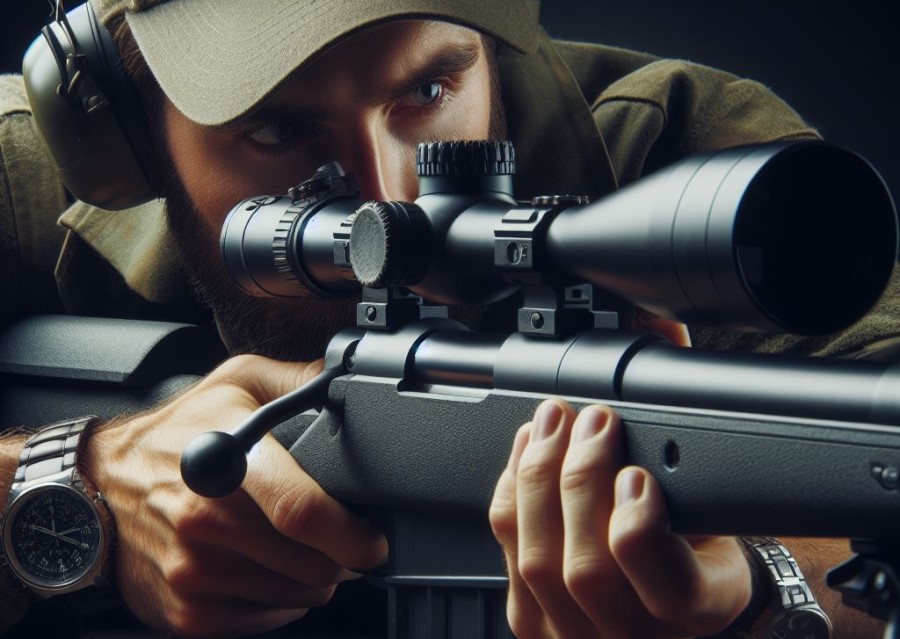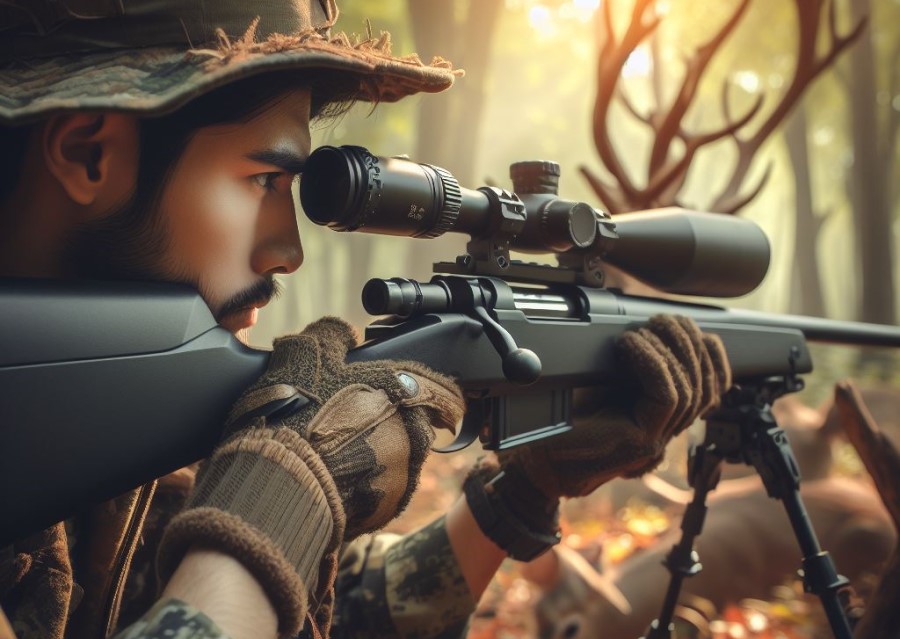Bore sighting a scope is a vital step in the process of zeroing or aligning the crosshairs of a firearm’s scope with the bore of the barrel. By doing so, you ensure that the bullet’s point of impact aligns with the crosshairs, thereby increasing accuracy.
In this article, we will explore the concept of bore sighting, its importance, and various methods to accomplish it effectively.
Bore sighting refers to the process of aligning the scope with the firearm’s barrel. It enables shooters to achieve a rough alignment before fine-tuning the sight at the shooting range.
Bore sighting can save time and ammunition during the zeroing process, making it an essential step for shooters of all skill levels.
Bore sighting is crucial because it establishes the initial alignment between the scope and the barrel, helping shooters get on target quickly.
Properly bore sighting a scope can significantly reduce the number of shots needed for final zeroing, saving both time and resources.
By understanding the concept of bore sighting and following the appropriate method for your firearm, you can achieve accurate and precise shot placement, enhancing your shooting experience.
What is Bore Sighting?

Bore sighting is a method used to align the sights of a firearm with the bore or the center of the barrel. It helps in ensuring that the bullet trajectory matches the line of sight. This technique is especially helpful when mounting a scope on a firearm.
Rather than firing live rounds to adjust the scope, bore sighting enables a preliminary alignment, making the process quicker and more efficient.
To bore sight a scope, you can use various tools like laser bore sights or optical bore sights. These devices are inserted into the barrel and project a laser or visual cue towards a target. By adjusting the scope to align with the projected mark, the sight becomes parallel to the bore.
Bore sighting can save time, ammunition, and reduce frustration when zeroing in a scope. It provides a starting point for adjustments, ultimately improving accuracy when shooting.
If you’re new to bore sighting, it’s recommended to consult the firearm’s manual or seek guidance from experienced shooters. Practice safe firearm handling at all times and ensure the firearm is unloaded before making any adjustments.
Why is Bore Sighting Important?

Bore sighting is crucial for accurate shooting, making it important for several reasons.
Firstly, it ensures that the scope is aligned with the firearm’s barrel, which is essential for precise aim. Without proper alignment, the point of aim may not match the point of impact, leading to missed shots.
Secondly, bore sighting saves time and ammunition during the initial sighting-in process, making it more efficient. By getting the scope close to the target, adjustments can be made easily, reducing the need for multiple shots to zero in the scope.
Moreover, bore sighting helps identify any potential issues with the scope or firearm, such as off-centered crosshairs or misaligned barrels. By addressing these issues early on, shooters can prevent frustrating and inaccurate shooting experiences.
Methods to Bore Sight a Scope

Discover the various methods to bore sight a scope and ensure optimal accuracy for your shooting experience. From visual bore sighting to using laser technology, collimators, and specialized tools, we’ll explore the different techniques in this section.
Get ready to elevate your shooting skills and learn how to achieve the perfect alignment between your firearm and scope. Say goodbye to guesswork and hello to precision. Let’s dive in and explore these bore sighting methods!
Visual Bore Sighting
- Ensure the rifle is unloaded and pointed in a safe direction.
- Set up a stable shooting platform, such as a shooting bench or a sandbag rest.
- Place your rifle in a secure position, ensuring it is stable and will not move during the sighting process.
- Look through the bore of the rifle and align it with a specific point or target in the distance.
- Without moving the rifle, adjust the reticle or crosshairs of the scope until they are aligned with the same point or target.
- Once aligned, lock the scope’s adjustments to prevent any inadvertent movement.
- Take caution to not disturb the alignment while tightening the adjustments.
- Confirm the alignment by visually inspecting the alignment of the scope’s reticle and the target.
- Once the alignment is confirmed, the rifle should be bore sighted and ready for fine-tuning at the range.
- Remember to follow safety protocols and always treat firearms with the utmost care.
Bore Sighting with Laser
To bore sight a scope using Bore Sighting with Laser, follow these steps:
- Begin by securing your firearm on a stable shooting platform.
- Insert the bore sight with the laser into the barrel of the firearm.
- Turn on the laser and align it with the target.
- Look through the scope and adjust the windage and elevation knobs until the crosshairs align with the laser dot on the target.
- Make any necessary adjustments to the scope to ensure accuracy.
Bore sighting with a laser is an effective method as it allows for precise alignment between the scope and the firearm. The laser provides a visible reference point on the target, making it easier to adjust the scope accordingly.
This method can save time and ammunition by getting your initial sight alignment close to the target, reducing the need for extensive adjustment during actual shooting.
When using this method, it is important to handle the firearm safely throughout the process. Always follow proper gun safety procedures and ensure that the firearm is unloaded when inserting the bore sight.
By employing the laser for bore sighting, you can quickly and accurately align your scope with your firearm, enhancing your shooting proficiency and increasing the chances of hitting your target.
Bore Sighting with a Collimator
To correctly bore sight a scope using a collimator, you can follow this method:
- First and foremost, make sure your firearm is unloaded and pointed in a safe direction.
- Next, attach the collimator to the end of the firearm’s barrel.
- Now, peer through the scope and adjust its position until the crosshairs are perfectly centered on the collimator’s target grid.
- While keeping the firearm still, use the collimator’s windage and elevation knobs to align its grid with the crosshairs.
- Afterwards, remove the collimator and mount the scope onto the firearm’s receiver.
- Look through the scope once more and adjust the windage and elevation knobs to align the crosshairs with the collimator’s target grid.
- To ensure proper alignment, fire a test shot at a target and make additional adjustments if needed.
By following these steps, you will be able to accurately bore sight a scope using a collimator. Remember to always handle firearms safely and adhere to proper shooting practices.
Bore Sighting Using Bore Sight Tools
When bore sighting a scope using bore sight tools, follow these steps for accurate alignment:
- Ensure the firearm is unloaded and remove any ammunition from the chamber.
- Secure the firearm in a stable shooting platform, such as a gun vise or sandbags.
- Choose the appropriate bore sight tool for your firearm. Different tools are available for various calibers.
- Insert the bore sight tool into the firearm’s barrel, making sure it is securely in place.
- Look through the scope and adjust the windage and elevation dials to bring the reticle closer to the bore sight tool. This will help in aligning the scope with the firearm.
- Rotate the bore sight tool slightly to ensure the reticle is centered on the tool.
- Make any necessary adjustments to the scope’s windage and elevation to align it precisely with the bore sight tool.
- Once the reticle is aligned, remove the bore sight tool from the barrel.
- Confirm the alignment by taking a few test shots at a suitable target, adjusting as needed.
Tips for Successful Bore Sighting

Looking to enhance your bore sighting skills? In this section, we’ll dive into some valuable tips that can help you achieve successful bore sighting.
From using a stable shooting platform to selecting the right bore sighting method for your firearm, and following manufacturer’s instructions, we’ve got you covered. Get ready to fine-tune your scope alignment and improve your shooting accuracy.
Use a Stable Shooting Platform
When bore sighting a scope, using a stable shooting platform is crucial to ensure accuracy and reliability. Follow these steps to use a stable shooting platform:
- Choose a sturdy shooting bench or rest: Use a shooting bench or rest that is stable and secure. This will provide a solid foundation for your firearm.
- Position your body correctly: Stand or sit in a comfortable and stable shooting position. Keep your body aligned with the shooting platform to minimize movement.
- Rest the firearm securely: Place the firearm on the shooting rest or bench, making sure it is firmly supported and doesn’t wobble or move.
- Grip the firearm properly: Hold the firearm with a firm grip, ensuring stability and control during the bore sighting process.
- Minimize body movement: Avoid unnecessary body movements while bore sighting. This helps to maintain a stable shooting platform and reduce any potential errors.
Pro-tip: Using a sandbag or shooting rest that supports both the front and rear of the firearm can further enhance stability and accuracy during bore sighting.
Choose the Right Bore Sighting Method for Your Firearm
If you want to choose the right bore sighting method for your firearm, consider the following tips:
- Identify the type of firearm you have. Different firearms may require different bore sighting methods.
- Consider your level of experience and skill. Beginners may find some methods easier to use, while more advanced knowledge is required for others.
- Take into account the specific conditions in which you will be using the firearm. Some methods are more suitable for outdoor shooting ranges, while others are better for indoor environments.
- Research and gather information on the various bore sighting methods available. To understand the pros and cons of each method, read reviews, watch videos, and consult professionals.
- Weigh the cost and availability of each method. Keep in mind that some methods may be more expensive or harder to find compared to others.
- Consider the accuracy and precision you need. Some methods may provide more precise results, while others may be sufficient for general sighting purposes.
- Take your personal preferences into account. Choose a method that aligns with your shooting style or preferences.
- Make an informed decision based on the factors above and choose the bore sighting method that best suits your firearm and shooting needs.
Remember, choosing the right bore sighting method is crucial for achieving accurate and precise shots with your firearm. It can greatly improve your shooting experience and increase your overall proficiency.
Common Mistakes to Avoid

When it comes to bore sighting a scope, avoiding common mistakes is crucial for achieving accurate results. In this section, we’ll dive into the pitfalls that many people encounter during the process.
From improperly aligning the bore sight to neglecting windage and elevation adjustments, and even disregarding environmental factors – we’ll explore how these mistakes can greatly impact your sighting efforts.
Stay tuned to discover the key dos and don’ts to ensure a successful bore sighting experience.
Improperly Aligning the Bore Sight
When bore sighting a scope, it is crucial to avoid the mistake of improperly aligning the bore sight. Here are the steps to ensure proper alignment:
- Secure your firearm in a stable shooting platform, such as a gun vise or sandbags.
- Attach the bore sight to the barrel of the firearm. Make sure it is properly seated and aligned.
- Look through the scope and adjust the windage and elevation dials to center the crosshairs on the bore sight’s target.
- While keeping the firearm still, remove the bore sight and take a test shot at a target downrange.
- Inspect the impact point of the test shot. If it is not aligned with the center of the target, repeat the process starting from step 2.
To avoid this mistake and ensure accurate bore sighting, it is crucial to follow these suggestions:
- Take your time and be patient when aligning the bore sight. Rushing can lead to imprecise results.
- Double-check that the bore sight is properly seated on the barrel before making any adjustments.
- Regularly calibrate and maintain your bore sight for optimal performance.
- Practice proper safety precautions when handling firearms and always follow manufacturer’s instructions.
Neglecting to Adjust Windage and Elevation
The mistake of neglecting to adjust windage and elevation when bore sighting a scope can result in inaccurate shots and frustration. To ensure successful bore sighting, follow these steps:
- Secure your firearm on a stable shooting platform.
- Choose the appropriate bore sighting method for your firearm.
- Align the bore sight with the center of the target.
- Look through the scope and adjust the windage (left-right) and elevation (up-down) controls.
- Make small adjustments until the crosshairs align with the bore sight.
- Repeat the process if necessary to fine-tune the adjustment.
Adjusting windage and elevation is crucial because it allows you to compensate for the bullet’s trajectory and ensure that your shots hit the target accurately. Neglecting to adjust windage and elevation can result in shots landing off target, wasting ammunition, and missing your intended mark.
Not Taking Environmental Factors into Account
When bore sighting a scope, one common mistake to avoid is not taking environmental factors into account. It is crucial to consider the conditions in which you will be shooting, as they can have a significant impact on your accuracy.
- Wind: Ignoring wind speed and direction can affect the trajectory of your bullet. Failing to consider the wind can result in missed shots or inconsistent groupings. Use wind flags or other indicators to gauge wind conditions.
- Temperature: Changes in temperature can cause the density of the air to vary, which can affect the flight of your bullet. Warmer temperatures can cause the air to be less dense, while colder temperatures can make the air denser. Adjustments may be needed to compensate for these changes.
- Humidity: Humidity levels can also have an impact on bullet flight. High humidity can make the air denser, similar to cold temperatures. This can affect bullet drop and overall accuracy.
- Elevation: Shooting at higher elevations can influence bullet trajectory due to differences in air pressure. When shooting at higher altitudes, consider adjusting your scope accordingly.
To ensure accuracy when bore sighting your scope, it is crucial to take these environmental factors into account. By considering these conditions, you can make the necessary adjustments to your scope to compensate for any potential changes in bullet flight.
Remember to always stay observant of your surroundings and make adjustments as needed to achieve optimal accuracy.
Frequently Asked Questions
How do you bore sight a scope without any tools?
To bore sight a scope without any tools, start by pulling out the bolt of your rifle and looking down the bore. Set your rifle on a secure rest, like sandbags, and place a target at a distance of 12 feet to 50 yards. Center the target in the bore and visually check that you are looking down the center of the bore. Then, adjust the windage and elevation dials on your scope to center the reticle on the target.
What is a laser bore sighting tool and how does it work?
A laser bore sighting tool is a device that projects a laser beam through the bore of your rifle, allowing you to align the reticle of your scope with the laser dot. There are two types of laser bore sighting tools: one that fits inside the rifle’s chamber and one that fits in the muzzle. Follow the manufacturer’s instructions to beam the laser through the bore and align the reticle with the laser dot on a wall.
What is the recommended method for bore sighting most deer rifles?
The recommended method for bore sighting most deer rifles is to set up a 25-yard target at the range. For bolt-action rifles, remove the bolt and look down the rifle’s bore to center it on the target. Then, adjust the windage knob to move the reticle to the right if it is left of the target’s center. Next, adjust the elevation to center the reticle on an orange circle placed on the target. The goal is to have the bullet impact 1 inch low from the center of the target.
What measurement is recommended for bore sighting ARs and rifles with scopes higher above the bore?
For ARs and rifles with scopes higher above the bore, a 25-yard impact of 1.5 inches low is suggested. This means that the bullet should impact 1.5 inches below the center of the target at 25 yards when bore sighting.
Why is bore sighting important for aligning a rifle’s barrel with its scope?
Bore sighting is important for aligning a rifle’s barrel with its scope because it ensures that the initial shot will hit the target. It saves time and expensive ammo by getting the rifle close to zero before heading to the range. Bore sighting also helps shooters determine if the scope is still accurate and allows for more efficient and enjoyable range trips.
What additional equipment is recommended for bore sighting?
In addition to a stable workspace, a gun vice, and a laser or standard bore sighter kit, a ruler is recommended for measuring the bullet’s impact. High-quality scope rings, bases, and rails are also recommended to ensure that your scope remains zeroed after bore sighting.

